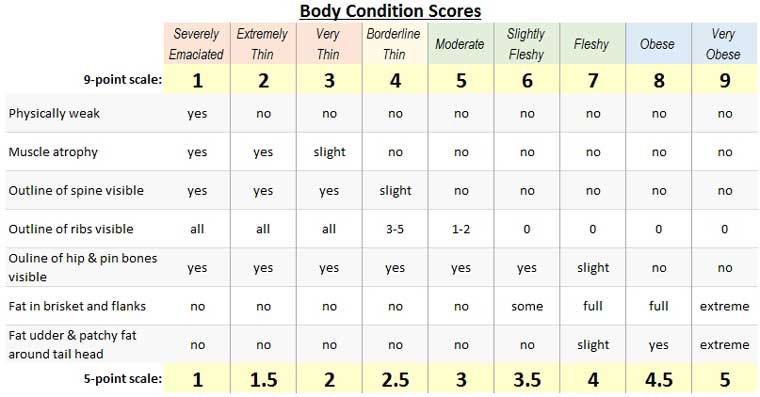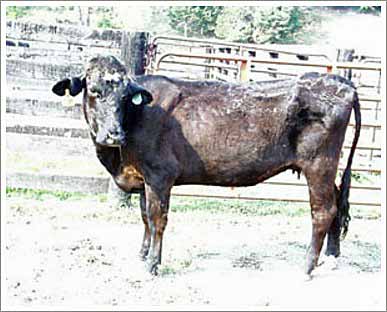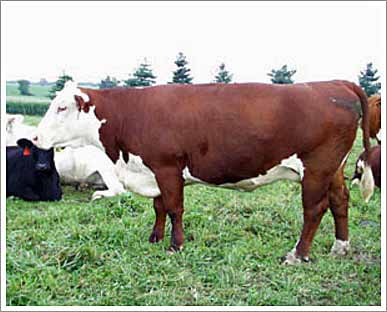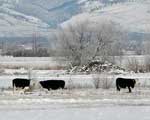Cattle Body Condition Scoring:
How (and why) to monitor body fat in your cattle herd

Body condition scoring is a simple technique used to estimate cattle body fat. Yet despite its simplicity, it is one of the most powerful tools in your herd management toolbox.
While it’s not hard to see whether cows are getting thinner or fatter, body condition scores provide a consistent standardized measurement system. Measurement is the first step in successful management.
Cattle body condition scores play a pivotal role in maximizing fertility in your breeding herd. They are used in almost all cattle nutrition and supplementation calculations. They are invaluable to your cattle finishing program if you want to consistently produce tender flavorful beef. They are the key to longer grazing seasons and one of your most important tools to keep cattle safe and healthy while grazing during the winter / dry season. And if you want to make use of compensatory gain to increase gain weights on pasture, you need to understand body condition scores.
Before you can begin to use body condition scores successfully, you need to “calibrate your eye” to recognize how different body fat levels look while your cattle are out on pasture. So in this article I will show you how use this simple but powerful tool and I will provide you with a brief overview of how to use body condition scores to guide your cattle management decisions.
Body Fat (%) by BCS score
Body condition scores (BCS) are simply a way of estimating different levels of body fat based on a standardized set of visual criteria. Most people use a 9-point scale (1, 2, 3, 4, 5, 6, 7, 8, 9) to categorize cattle from thin to obese, but some people prefer to use a 5-point scale (1, 1.5, 2, 2.5, 3, 3.5, 4, 4.5, 5). Both scales use identical criteria, but assign different numbers to the criteria. I provide the conversions between the scale later in this article.
Before I explain the criteria used to "read" body fat levels on pasture, here is a diagram that shows the difference in body fat levels at each of the body condition scores:
 Cattle Body Condition Scores vs Body Fat (%)
Cattle Body Condition Scores vs Body Fat (%)The average weight difference between each of the different body condition scores is approximately 100 lbs (45 kg) for a medium-framed cow.
So, the weight difference between a cow with a BCS of 5 and a BCS of 7 is approximately 200 lbs. And a very thin cow with a BCS of 3 would have to gain approximately 400 lbs to reach a BCS of 7 - the level at which her fertility and her milk production is optimal.
Cattle body fat affects performance and income
Cattle body fat has a huge impact on the performance of your cows and calves, which directly affects your farm profitability. Here are a few quick charts to show you just how important it is to monitor and manage body fat in your cow-calf herd:
Length of the infertile period after calving (by BCS)
Body condition at calving time affects the length of the time before cows reach their first estrus and can be re-bred:

Pregnancy rate after a 60-day breeding season (by BCS)
Body condition at calving time also has a dramatic effect on conception rates in the next breeding season:

Differences in milk production (by BCS)
Because the dairy industry is able to measure and record how much milk every cow produces every single day, we also know that body fat has a huge impact on milk production. Here is a study that measured total milk production over a 305-day period:

Calf weight at weaning on day 240 (by BCS of the mother):
More milk means faster growing calves, which leads to higher weaning weights among your calves. Here's a study highlighting the difference in weaning weights (weaned at 240 days) based on how fat the cows were at calving time.

Using body fat for better herd management:
Before we get to the criteria used to measure body condition scores, I want to go over the major parts of the 9-point BCS scale to explain how they affect your herd management decisions.
A BCS of 1 through 3 is used for cows that are very thin. Cattle that get this thin are at risk of serious health issues due to malnutrition and excessively low body fat reserves. Getting this thin also has serious long-term consequences to their fertility.
A BCS of 4 is borderline too thin. Cattle that get this thin are increasingly vulnerable to health issues. Their fertility in the next breeding season may also be compromised, even if they are able to regain a BCS of 7 prior to the next calving season. If possible, never let your cattle get this thin.
A BCS of 5 through 7 is the healthy range. It is perfectly okay to let cattle body fat levels fluctuate as long as they stay within this safe range between 5 and 7. They should never drop below a BCS of 5 and they should regain a BCS of 7 before they begin calving.
To maximize fertility, cattle should have a BCS of 7 when they calve. The closer cattle are to a BCS of 7 when they calve, the shorter their infertile period will be after calving and the sooner they will be receptive for re-breeding. That's why maximizing BCS at calving time is a key strategy for improving conception rates in your cattle herd.
Allowing cattle to lose a little body fat during the winter grazing season (or dry season) to match seasonal changes in grass quality allows you to significantly reduce your winter feed costs because it takes far less supplements (or expensive hay and silage) than if you try to keep cattle in optimal condition (BCS of 7) all year round. You should also calve during the growing season to give your cows time to fatten up on cheap pasture before calving begins. The supplements you use to support your pasture rotation should manage weight loss in your cow-calf herd so that body condition scores never drop below a BCS of 5.
A BCS of 5 to 7 is also the target body fat range when slaughtering beef cattle for market. Cattle tend to grade higher the closer they are to a BCS of 7 because there will be more fat in the meat. More fat = more tenderness. But above a BCS of 7, cattle will grade lower because there is a penalty for being too fat since excess fat will just end up in the waste bin.
A BCS of 8 and 9 are for cattle that are obese. Cattle that get this fat will be less fertile - many hormonal functions stop working correctly when cattle are too fat because fat absorbs hormones. This much fat also negatively affects meat quality and carcass grades (too much fat has to be trimmed off the carcass and discarded and too much fat in the meat negatively affects beef texture and the eating experience). Getting this fat also begins negatively affecting cattle health.
How to identify body condition scores on pasture:
This table outlines the criteria used to assign body condition scores to your cattle. Print a copy of the table and keep it with you on pasture so you can practice until you can recognize body condition scores without it. You can also see the conversions between a 9-point and a 5-point scale.

Modified from: Pruitt and Momont, Cattle 87-9, "Effects of Body Condition On Reproductive Performance of Range Beef Cows" and from Virginia Cooperative Extension, 400-795, Body Condition Scoring Beef Cows.
Cattle Body Condition Score Photos:
And now let's look at a series of photos of the nine body condition scores to help you start training your eye.
These photos are courtesy of the Virginia Cooperative Extension materials, taken from their Body Condition Scoring Beef Cows (400-795) article.
 BCS 1. Emaciated with muscle atrophy and no detectable fat. Tail head and ribs project predominantly. Animal is physically weak.
BCS 1. Emaciated with muscle atrophy and no detectable fat. Tail head and ribs project predominantly. Animal is physically weak. BCS 2. Poor condition with muscle atrophy and no detectable fat. Tail head and ribs prominent.
BCS 2. Poor condition with muscle atrophy and no detectable fat. Tail head and ribs prominent. BCS 3. Thin condition. Slight muscle atrophy. All ribs visible. Very little detectable fat.
BCS 3. Thin condition. Slight muscle atrophy. All ribs visible. Very little detectable fat. BCS 4. Borderline condition. Outline of spine slightly visible. Outline of 3 to 5 ribs visible. Some fat over ribs and hips.
BCS 4. Borderline condition. Outline of spine slightly visible. Outline of 3 to 5 ribs visible. Some fat over ribs and hips. BCS 5. Moderate, good overall appearance. Outline of spine no longer visible. Outline of 1-2 ribs visible. Fat over hips but still visible.
BCS 5. Moderate, good overall appearance. Outline of spine no longer visible. Outline of 1-2 ribs visible. Fat over hips but still visible. BCS 6. High moderate condition. Ribs and spine no longer visible. Pressure applied to feel bone structure. Some fat in brisket and flanks.
BCS 6. High moderate condition. Ribs and spine no longer visible. Pressure applied to feel bone structure. Some fat in brisket and flanks. BCS 7. Good, fleshy appearance. Hips slightly visible but ribs and spine not visible. Fat in brisket and flanks, with slight udder and tail head fat.
BCS 7. Good, fleshy appearance. Hips slightly visible but ribs and spine not visible. Fat in brisket and flanks, with slight udder and tail head fat. BCS 8. Fat, fleshy and over-conditioned. Bone structure not visible. Large patchy fat deposits over ribs, around tail head and brisket.
BCS 8. Fat, fleshy and over-conditioned. Bone structure not visible. Large patchy fat deposits over ribs, around tail head and brisket. BCS 9. Extremely fat, wasty and patchy. Mobility possibly impaired. Bone structure not visible. Extreme fat deposits over ribs, around tail head and brisket.
BCS 9. Extremely fat, wasty and patchy. Mobility possibly impaired. Bone structure not visible. Extreme fat deposits over ribs, around tail head and brisket.I encourage you to read the complete article about Body Condition Scoring Beef Cows (400-795) from Virginia Cooperative Extension. It covers some excellent additional points about how to recognize and use body condition scoring in your herd management decisions.
I also recommend reading the University of Georgia Extension article about Body Condition Scoring Beef Cows (B 1308), which includes another completely different set of photos and a whole bunch more tips on how to use body condition scoring to improve your herd management.
How often should I record body condition scores?
Even though you see your cattle every single day, you should record their body condition scores in a spreadsheet at regular intervals (i.e. once per month), so you can track subtle changes in body condition. This allows you to intervene if the herd is losing weight faster than expected or is at risk of getting too thin. It also lets you quickly see identify the effect of small changes in your nutrition program (new supplements, different grazing area, small changes in your grazing management, etc.)
Regularly recording BCS also allows you to compare body fat levels from year to year, which gives you feedback about how changes in your nutrition and herd management are impacting your herd's performance.
This database is also invaluable at breeding and weaning time because you can look up each cows' BCS history to see whether body fat or some other factor are affecting weaning weights, conception rates, etc. Not only does this give you an extra tool to troubleshoot problems, but this database also helps you decide which cattle to cull and which to re-breed.
Body condition scoring is not just about tracking the whole herd. It is also a very useful tool for identifying high-risk animals that need special management (too thin, losing weight faster than the rest of the herd). These high-maintenance animals can get extra supplementation, they can be weaned earlier than the rest of the herd, or they can be removed from the main herd to give them better nutrition without having to spend extra money on the whole herd. Plus, this allows you to flag them as high-maintenance animals, which puts them at the top of the cull list later in the year when they are fat enough to give you a good price at the markets.
You can even use your body condition scores to fine-tune the date of your calving season. If your cows have an average BCS of 5 at the end of the winter or dry season and you want them to reach a BCS of 6.5 by calving time, then they need to gain approximately 150 lbs of body fat (plus any extra weight related to pregnancy) before they calve. If you schedule your calving season to begin 40 days after the start of the growing season, your cattle will need to gain 3.75 lbs/day during those 40 days to reach their target body condition score by the time calving season starts. Is your pasture quality and your grazing management capable of producing that much gain per day? Your livestock nutritionist can tell you based on a simple forage analysis of your pasture grass.
Tips for Body Condition Scoring
One of the things that makes body condition scoring so useful is that it is so easy to use on pasture. You don't need to bring the herd into the corral to record body condition scores. You can simply sit in the pasture with a list of ear-tag numbers and work your way down the list until you've seen all the cattle in the herd. And it won't interfere with their grazing and weight gains.
Once you have all your individual BCS scores, make sure you also calculate a monthly average for the whole herd so you can track subtle changes in body condition score as the seasons progress. You should also record the percentage of animals at each BCS score (i.e BCS 4 = 12%, BCS 5 = 73%, BCS 6 = 15%).
Individual BCS scores allow you to manage the individual animals in your herd, but the monthly averages and breakdown by BCS provide vital feedback about your farm's nutrition and herd management strategy. Both are equally important.
"An ounce of prevention is worth a pound of cure." Body condition scoring is the predictive tool that allows you prevent many problems long before they get expensive and difficult to fix.
Using BCS to improve your herd management:
Now that you know how to recognize body condition scores in your cattle herd, here are some areas of herd management that will be greatly improved by your understanding of cattle body condition scores:
 |
How to design a cattle supplement and mineral program for your cattle herd (coming soon) |
|
How to calculate target slaughter weights for your beef cattle finishing program | |
|
Compensatory Gain - a powerful strategy for increasing weight gains on pasture | |
|
How to manage your pasture rotation after the growing season ends (winter / dry season) | |
I hope this article has given you a good introduction to cattle body condition scoring. It is a very simple, non-invasive, and remarkably easy-to-use tool. Yet it is also one of the most powerful tools that you can add to your herd management toolbox.
Do you use body condition scoring on your farm? Share your tips and experiences with body condition scoring in the comments below so others farmers can learn from them too!
...
If you'd like to be notified when I release future cattle farming articles, sign up for my email notifications or follow me on Facebook or Twitter.
References:
- Berry, D.P., F. Buckley, Dillon P. 2007. Body condition score and live-weight effects on milk production in Irish Holstein-Friesian dairy cows. Irish Journal of Agricultural and Food Research 50: 141-147, 2011
- Bridges, A. Lemenager, R. Impact of Body Condition at Calving on Reproductive Productivity in Beef Cattle. Department of Animal Sciences, Purdue University, Internet notes.
- Houghton, PL, RP Lemenager, LA Horstman, KS Hendrix, and GE Moss. 1990. Effects of body composition, pre- and postpartum energy level and early weaning on reproductive performance of beef cows and preweaning calf gain. J. Anim. Sci. 68:1438.
- Gergovska, Z. Y. Mitev, T. Angelova, D. Yordanova, and T. Miteva. 2011. Effect of Changes in Body Condition Score on the Milk Yield of Holstein-Friesian and Brown Swiss Cows. Bulg. J. Agric. Sci., 17: 837-845.
- Kunkle, WE, RS Sands, and DO Rae. 1998. Effects of body condition on productivity in beef cattle. Department of Animal Sciences, Florida Cooperative Extension Service, UF/IFAS. SP-144.
- Selk, G.E., R.P. Wettemann, K.S. Lusby, J.W. Oltjen, S.L. Mobley, R.J. Rasby and J.C. Garmendia. 1988. Relationships among weight change, body condition and reproductive performance of range beef cows. J. Anim. Sci. 66: 3153.









